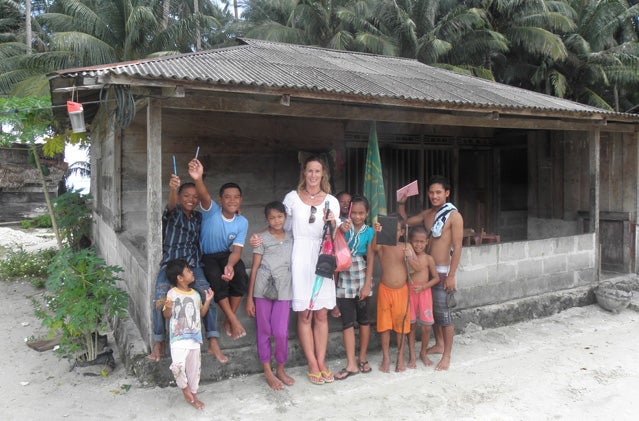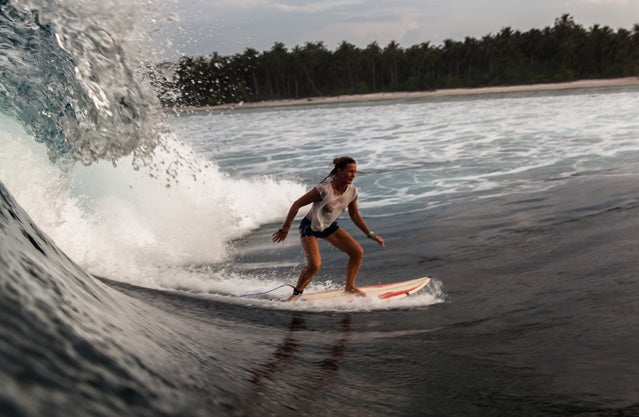
By
Not long ago, villagers on the remote Mentawai island chain off the west coast of Sumatra lived without electricity, cell phone reception, and even a local government. But, as has happened to many other tropical paradises, word got out about the islands' exceptional surf. Their perfectly curled waves, white sand beaches, turquoise water, and coconut palms have earned the islands the nickname “” among surfers, who started arriving there en masse in the late 1990s. If all goes according to the plans of developers and the newly formed island government, the Mentawais will be the next hot spot in Indonesia travel guides.
But a motivated English surfer and a group of ambitious locals are working hard to ensure that island residents get a seat at the table and that the Mentawais grow in a sustainable fashion.
In 2010, a devastating tsunami flattened the western edges of the Mentawai archipelago. During the rebuilding efforts, a Portuguese boat captain named Goncalo Ruivo struck up a conversation with an English surfer named Elizabeth Murray. Having recently taken up residence in Katiet, a surfing hub of the islands, Murray told Ruivo about a passion project to start a local school that would teach lessons in English and surfing.  This struck Ruivo, since he recognized these as essential for local Mentawaians who want to prosper in the changing economic landscape. Murray, who went to college in the United States on a sports scholarship, was particularly adamant about teaching young girls to swim and surf.
In October of 2012, Ruivo visited the village where Murray was working and found himself “amazed with the success of her program,” he says. Murray taught her first English lessons on the sand earlier in 2012 using a whiteboard tacked to a coconut tree. A fluid group of about 15 kids would meet in the afternoons, in the hours after school and before supper. After about a month, Murray moved her lessons into an unused community center, and the group swelled into a loyal crowd of about 90 pupils, including the initial kids and their parents. The sight inspired Ruivo to donate proceeds from a photo book he'd published following the tsunami to fund Murray's newly minted non-profit organization, called .
Over the last 15 years, these islands, from total oblivion, have turned into the most prized surfing destination for surfers from all around the world,” says Ruivo, a 46-year-old surf boat captain in Sumatra who has made a living ferrying boatloads of surf tourists to the islands since 2007. But in spite of the tourism boom, “the local population benefits little or nothing apart from a few basic jobs” as crewmembers, resort maids, and cooks, he says. “The surfers leave little or nothing to the local communities and I just feel it's not fair to use their waves, their wonderful beaches, sea, natureÔÇöenjoy the best holidays everÔÇöand give nothing back.”
In his short time in Sumatra, Ruivo says he has seen “a lot of sad situations” concerning the living conditions in the Mentawais. The people's relationship to mainland Sumatra is marred by a history of prejudiceÔÇöthe villagers, who sustain themselves mainly by selling coconuts and cacao, are viewed as primitiveÔÇöand the islands are far enough away from the central government so as to be overlooked for basic necessities like clean drinking water, health services, and education. The 2010 tsunami has left more than without permanent housing.
The one thing Sumatra has been sending to the Mentawais en masse during the past decade is a small fleet of charter boats loaded with surfers. SurfersÔÇötheir lifestyles and the money they spendÔÇörepresent an opportunity for improvement and progress. But without English skills or business savvy, locals are struggling to take advantage of the changing economic tide.
“There's a collision of one very simple, relatively untouched culture with the modern-day surf culture and I can only see it as beneficial to have the locals aware of what's happening in their own backyard,” says Murray. “It's vital to have the communities involved in the development of their region. If it's left to foreigners or even other people in Indonesia, I think it's more likely to lead to something detrimental.”

BLESSING OR CURSE?
For many small communities in Indonesia and other developing Polynesian countries with world-class waves, surfing opens the door to mainstream travelers and the development that inevitably follows. The same is true of the Mentawais.
In 2002, for instance, only a single land-based surf camp existed on the island's beaches and reaching it required a five-hour overnight boat ride from Sumatra. A decade later, there are more than 10 resorts up and running and several more under constructionÔÇösome of which feature cable TV and Wi-Fi. All of these resorts are owned by Westerners.
A new airstrip has been paved so that tourists can fly in directly. The foundation for Indonesia's next big paradise attraction has been laid. But what looks to outsiders like a blessing bestowed upon a poorer corner of the globe can, to locals, manifest as a curse in disguise.
Take Kuta, the surf capital of Bali, for example. The number of international travelers to the beach village exploded in the 1970s and the rampant tourism infrastructure that followedÔÇöexclusive resorts, 7-11 stores, fast-food chainsÔÇöhas forever changed the local economy and marred the environment that drew visitors in the first place. High-rise hotels and garbage piles have become part of the landscape.
That kind of unfettered development, as it unfolds in other parts of Bali and spreads to nearby islands, has become known as “.” Kuta's economy has taken off, but arguably at the cost of its social and environmental wellbeing and the cultural identity of the locals. On the Mentawais, the fear is that coastal developments can exacerbate erosion, contribute to deforestation, and generally bring more plastic, trash, and pollutants.
“Bali is a very good example of what we don't want to happen in the Mentawais,” says Murray. In November, Murray met with various conservation organizations on Bali to help raise money for A Liquid Future. She's confident they'll be sympathetic to her cause, given the environmental degradation and rampant exploitation of the island's famous shores. A common observation shared by surfers who visit the Mentawais is the noticeable lack of plastic floating in the waves just offshore in comparison to the other popular breaks in Indonesia.
The question on the mind of Jess Ponting, a tourism professor at San Diego State who has studied the advancement of tourism in the Mentawais extensively, is, “Can we make this work for everyone this time around?”
NEO-COLONIAL
“For a lot of locals, especially the ones who don't speak English, the development kind of takes place around them,” says Ponting. “Neo-colonial” is how he describes locales where foreign-controlled companies have taken hold of the economy, because industry tends to privatize the benefits while socializing the environmental and social costs. “The major industry hasn't made an effort to include locals in the economy and they don't know how to include themselves.”
Ponting runs the at San Diego State, which funds surf tourism research around the globe and is ramping up a sustainable surf certification program, which would function as a kind of tourism treaty among developers and local governments. The certification criteria aims to curb the kind of competition that can evolve into what Ponting calls a “race to the bottom,” in which travel companies and resorts undercut the opposition until their profit margins are razor thin and the cost is offset to the surrounding environment. What's needed, first and foremost, Ponting argues, is government regulation.
The Mentawais are still catching up on that front. The islands' first government congress convened in 2006; before then, the islands were regulated, at a distance, from Sumatra.
A new front of sustainability-minded surfersÔÇösome of them alumni of Ponting's centerÔÇöis emerging to nip the social and environmental issues at early stages. They are setting up with tourism operators and the surf industry to conserve wave breaks in Papua New Guinea, Liberia, Nicaragua, Peru, and elsewhere.
A STEP UP
Achieving fair and equitable tourism is stamped into some of Murray's earliest memories. Her grandfather helped build one of the first resort-hotels in the Canary Islands, off the west coast of Morocco, in the 1980s. Even as a child, Murray sensed “uneasy feelings” between well-off tourists and locals, who Murray says “were always on the bottom rung.”
With A Liquid Future, she hopes to break the pattern and bring the locals up to speed on the implications of tourism on their livelihoods. That way, Murray reasons, they'll at least have the choice about whether to participate, rather than be relegated to passive observers without a voice.
“There's often a negative association with developing tourism in underdeveloped parts of the world, so I'm trying to help the locals in ways they've expressed they'd like to be helped,” Murray says. “These are small steps, but this is about timing. Timing is critical in these places.”
ÔÇöGregory Thomas